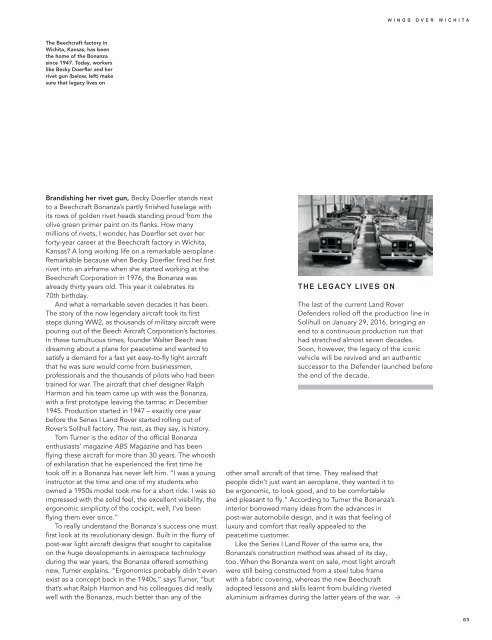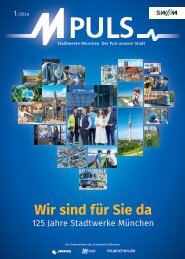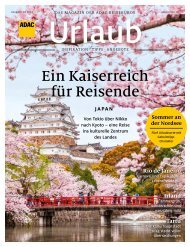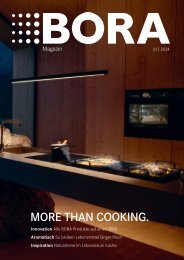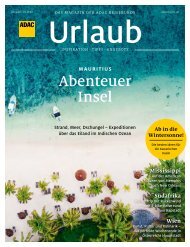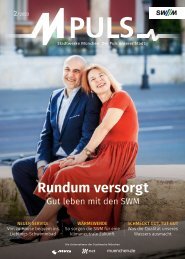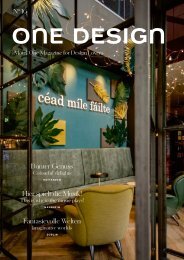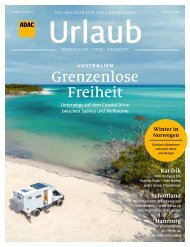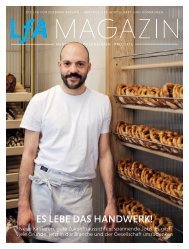ONELIFE #34 – English
Land Rover steht für höchste Allradkompetenz, umfassenden Komfort und anspruchsvolle Technik. Diesem Geländewagen ist kein Weg zu weit und keine Aufgabe zu schwer – getreu dem Slogan „Above and Beyond“. ONELIFE vermittelt Land Rover-Kunden genau dieses Gefühl von Abenteuer und Freiheit.
Land Rover steht für höchste Allradkompetenz, umfassenden Komfort und anspruchsvolle Technik. Diesem Geländewagen ist kein Weg zu weit und keine Aufgabe zu schwer – getreu dem Slogan „Above and Beyond“. ONELIFE vermittelt Land Rover-Kunden genau dieses Gefühl von Abenteuer und Freiheit.
You also want an ePaper? Increase the reach of your titles
YUMPU automatically turns print PDFs into web optimized ePapers that Google loves.
WINGS OVER WICHITA<br />
The Beechcraft factory in<br />
Wichita, Kansas, has been<br />
the home of the Bonanza<br />
since 1947. Today, workers<br />
like Becky Doerfler and her<br />
rivet gun (below, left) make<br />
sure that legacy lives on<br />
Brandishing her rivet gun, Becky Doerfler stands next<br />
to a Beechcraft Bonanza’s partly finished fuselage with<br />
its rows of golden rivet heads standing proud from the<br />
olive green primer paint on its flanks. How many<br />
millions of rivets, I wonder, has Doerfler set over her<br />
forty-year career at the Beechcraft factory in Wichita,<br />
Kansas? A long working life on a remarkable aeroplane.<br />
Remarkable because when Becky Doerfler fired her first<br />
rivet into an airframe when she started working at the<br />
Beechcraft Corporation in 1976, the Bonanza was<br />
already thirty years old. This year it celebrates its<br />
70th birthday.<br />
And what a remarkable seven decades it has been.<br />
The story of the now legendary aircraft took its first<br />
steps during WW2, as thousands of military aircraft were<br />
pouring out of the Beech Aircraft Corporation’s factories.<br />
In these tumultuous times, founder Walter Beech was<br />
dreaming about a plane for peacetime and wanted to<br />
satisfy a demand for a fast yet easy-to-fly light aircraft<br />
that he was sure would come from businessmen,<br />
professionals and the thousands of pilots who had been<br />
trained for war. The aircraft that chief designer Ralph<br />
Harmon and his team came up with was the Bonanza,<br />
with a first prototype leaving the tarmac in December<br />
1945. Production started in 1947 <strong>–</strong> exactly one year<br />
before the Series I Land Rover started rolling out of<br />
Rover’s Solihull factory. The rest, as they say, is history.<br />
Tom Turner is the editor of the official Bonanza<br />
enthusiasts' magazine ABS Magazine and has been<br />
flying these aircraft for more than 30 years. The whoosh<br />
of exhilaration that he experienced the first time he<br />
took off in a Bonanza has never left him. “I was a young<br />
instructor at the time and one of my students who<br />
owned a 1950s model took me for a short ride. I was so<br />
impressed with the solid feel, the excellent visibility, the<br />
ergonomic simplicity of the cockpit, well, I’ve been<br />
flying them ever since.”<br />
To really understand the Bonanza's success one must<br />
first look at its revolutionary design. Built in the flurry of<br />
post-war light aircraft designs that sought to capitalise<br />
on the huge developments in aerospace technology<br />
during the war years, the Bonanza offered something<br />
new, Turner explains. “Ergonomics probably didn’t even<br />
exist as a concept back in the 1940s,” says Turner, “but<br />
that’s what Ralph Harmon and his colleagues did really<br />
well with the Bonanza, much better than any of the<br />
THE LEGACY LIVES ON<br />
The last of the current Land Rover<br />
Defenders rolled off the production line in<br />
Solihull on January 29, 2016, bringing an<br />
end to a continuous production run that<br />
had stretched almost seven decades.<br />
Soon, however, the legacy of the iconic<br />
vehicle will be revived and an authentic<br />
successor to the Defender launched before<br />
the end of the decade.<br />
other small aircraft of that time. They realised that<br />
people didn’t just want an aeroplane, they wanted it to<br />
be ergonomic, to look good, and to be comfortable<br />
and pleasant to fly.” According to Turner the Bonanza’s<br />
interior borrowed many ideas from the advances in<br />
post-war automobile design, and it was that feeling of<br />
luxury and comfort that really appealed to the<br />
peacetime customer.<br />
Like the Series I Land Rover of the same era, the<br />
Bonanza’s construction method was ahead of its day,<br />
too. When the Bonanza went on sale, most light aircraft<br />
were still being constructed from a steel tube frame<br />
with a fabric covering, whereas the new Beechcraft<br />
adopted lessons and skills learnt from building riveted<br />
aluminium airframes during the latter years of the war.<br />
63


